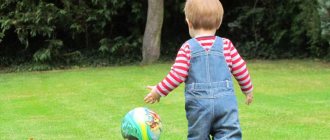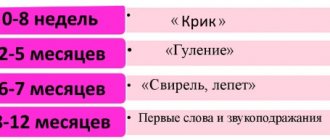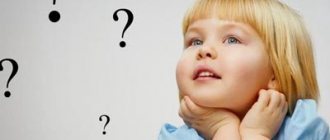A child’s speech at 2 years of age is actively formed against the background of the development of basic mental processes. Thinking helps him compare objects with each other and establish simple connections. Increasing the stability of attention allows you to listen to stories or reading by an adult. Memory and perception are increasingly improved and make it possible to master the norms of the native language with great success. Listening to short fairy tales and short stories is already meaningful; a child can repeat after an adult complex words, simple phrases, and retell a small part on his own.
In the second year of life, the baby is interested in everything that happens around him. He observes the objects of the surrounding world and masters the actions that can be performed with them. The main guides to the world of new information are adults from the immediate environment. But the baby can get help and new knowledge from them if he speaks. Communication with loved ones is the main incentive to master the native language between the ages of two and three years.
Features of speech development of children 2–3 years old
A two-year-old child has already mastered speech to such an extent that he can talk about his impressions, explain what he needs, and establish communication with peers and adults.
The normal development of a child’s speech at 2 years old leads to the fact that by the age of 2.5 years his vocabulary ranges from 1 thousand to 1200 words. This amount is 3-4 times more than the vocabulary with which he arrived at two years old. Most often he uses nouns (60% of the total vocabulary) and verbs (on average 25% of the total number of words). There are adjectives (about 10%), pronouns, prepositions, and adverbs.
Two-year-old children use participles, gerunds and numerals less often. By adjectives, child means:
- size of objects (large, small);
- color (green, red, blue, yellow, white, black);
- properties of objects (sweet, sour, cold, hot);
- qualities (good, bad);
- shape (round, square, triangular).
Generalizing words, such as toys, fruits, vegetables, clothes, furniture, dishes, animals, actively appear in the baby’s speech. He can also confuse objects from the same group, calling shoes and boots, and slippers, and even short boots, or the very concepts of vegetables and fruits. Lighter words (bi-bi instead of the word car) are becoming less and less common in a child’s speech.
Word creativity is actively developing, the baby comes up with words himself. Proof that at this age children are able to understand the sound side of a word can be seen in the textbook example given by Korney Chukovsky in his book “From Two to Five”: mazelin - Vaseline, mocress - compress.
Grammatical features of speech
The main content of children's speech at this age is simple narrative or exclamatory sentences. Complex sentences appear infrequently; their examples should be given in their speech by the baby’s parents. For example, “we won’t go for a walk today because it’s raining,” or “now we’ll read a book and then we’ll sleep.” Words in sentences in children of the third year of life are consistent in gender and number, but errors in case endings are often encountered.
Interrogative sentences are still asked by intonation, although children at this age are already able to use question words: where, why, when, how. You can suggest to your child: “Ask grandma where the car is?”, “Ask dad why the tea is hot?”, thereby giving examples of interrogative sentences.
Sound pronunciation
In the third year of a child’s life, the organs of pronunciation have become significantly stronger, the muscles of the tongue, lips, and lower jaw work more harmoniously. However, in the sound pronunciation of two-year-olds there are often many difficulties encountered, although the kids try to bring it as close as possible to the speech that sounds around them.
Most often, the pronunciation of hissing sounds suffers, which are replaced by whistling sounds, as they are easier in articulation (kasya - porridge, syapka - hat, koska - cat). Hard sounds can be replaced by soft ones (lapa - lyapa, dai - dyai), when consonants coincide, one of them is not pronounced, falls out, especially if these are sounds such as sh, zh, shch, ts, ch, l, r (stay - that , grass - tavka).
The child shortens words of 3-4 syllables, swaps syllables, and skips individual sounds, although in simple words he pronounces the same sounds flawlessly. The differences between the sound pronunciation of children of the same age by this period can be very significant. By the age of 3, some children master all the sounds of their native language, even the difficult-to-articulate sound p, while others have unclear speech with the absence of most sounds or no speech at all.
Age norms for speech development of preschool children
We all look forward to our baby's first word. And this is understandable - the appearance of speech is one of the most important indicators of the normal mental development of a child. And now the first word has already been said, but what next? What should a child be able to do at 2-4 years old, 5-6 years old? We will try to give a brief answer to this question that worries many parents.
Speech development of children 2-3 years old
Experts consider the age from two to three years to be critical in terms of speech development and recommend making the first visit to a speech therapist to answer the question “is everything okay with speech?”
Sound pronunciation . In the speech of a child of the third year of life, the sounds [s'], [l'], [y'], as well as [g], [x], [k], [m], [p], [b] should appear. , [n], [v], [f], [d], [t] (and their soft pairs), all vowels. However, the pronunciation of many sounds is still far from perfect, which at this age stage is characteristic of children's speech, since the mobility of the muscles of the tongue and lips is not yet sufficiently developed. The child replaces many difficult sounds with easier ones to pronounce. Thus, the baby often replaces hissing sounds ([sh], [zh], [ch'], [sch'] with soft whistling sounds: “syapka” (hat), “zyuk” (beetle), “tsyaynik” (teapot), "senok" (puppy). Sometimes, instead of the sound [ch'], a child can pronounce [t']: “tyasy” (clock). Some children at this age replace hissing sounds with hard whistling sounds: “sapka” instead of hat; hard whistling - soft whistling: “syanki” (sledge), “zyayka” (bunny). The consonants [р], [р'], [л] are absent or replaced by the sounds [л'], [й]: “yba” (fish), “giya” (weight), “yaboko” (apple), “dvel” (door), “golubi” (pigeons), “may” (chalk).
Lexicon. The child’s passive and active vocabulary quickly expands: by the age of 2 it reaches approximately 300 words, and by the age of 3 – up to 1000 words. In addition to nouns and verbs, the child increasingly uses adjectives, adverbs, prepositions, and pronouns. In the third year of life, the baby listens with pleasure and perceives simple fairy tales and stories, and easily carries out simple verbal instructions.
Phrasal speech. Experts are unanimous that by the age of 2, the baby should already have formed phrasal speech. Even if the phrases are not always clear yet and consist of two words, often babbling. For example: MOTHER, PI (mom, I’m thirsty). DE UYAT (let's go for a walk). The main thing is that a phrase (sentence) appeared. But the sentences of three-year-old children become complex, with conjunctions “because”, “or”, “so that”. And, although in their speech there is still a lot of incorrect use of endings (“Look how many balls!”), suffixes (“I have a doll”), agreements (“This is my doll!”), stresses (“The spoon is on the table” ), gradually they become less and less, they become random and disappear at approximately 5-6 years.
Speech development of children 3-4 years old
The fourth year is the age of “why”. Children constantly ask adults questions that cannot be ignored. We must patiently and clearly answer all the “why?”, “why?”, “how?” During this period, the child’s greatest sensitivity to language is revealed.
Sound pronunciation (see “Speech development of children 2-3 years old”). A child of the fourth year of life correctly pronounces the whistling sounds [s], [z] and [ts]. At this age, he still cannot always correctly pronounce the hissing sounds [w], [zh], [ch'], [sh'] and often replaces them with whistling sounds [s], [z], [ts]: “kasa” ( porridge), “nozyk” (knife), “klyuts” (key). The baby can replace sonorant [r], [r'], [l] with the sound [l'], less often [th]: “lyabota” (work), “leka” (river), “lyampa” (lamp), “kayandas” "(pencil), "get tired" (tired).
The syllabic structure of the word. In some words, the child omits or rearranges not only sounds, but also entire syllables, for example, he can pronounce the word car as “amabil”, store as “gamazin”, suitcase as “bagman”, temperature as “tematura”, etc. But this applies to words with a complex syllabic structure, to long and new words.
Lexicon. By age four, a child's active vocabulary nearly doubles to approximately 2,000 words. In his speech, in addition to nouns and verbs, pronouns (my, yours, ours), adverbs (cold, tasty), and numerals (one, two) appear more and more often. If previously the child used only qualitative adjectives (soft, warm), now he also uses possessive ones (uncle's hat, cat's tail).
The grammatical structure of speech is still being formed, so incorrect use of endings, suffixes, prefixes, and word agreements in a sentence is acceptable (“Buy a blue ball!”, “This little dog was sitting under the chair,” “I’m drawing”). Arbitrary use of stress is also a variant of the norm: “cold water”, “my hand hurts”.
Phrasal speech. The construction of phrases also becomes more complicated. If earlier the baby, asking for an apple, said: “Give me an apple,” now he can pronounce this phrase like this: “Give me a big (small or red) apple,” that is, indicate the size or color of the object. However, a child cannot always coherently and clearly tell what he saw on the street or retell a fairy tale.
Speech development of children 4-5 years old
In the fifth year of life, the child’s speech becomes more varied, more correct, and richer.
Sound pronunciation . Children of this age master a clear and pure pronunciation of hissing sounds [w], [zh], [h'], [sh'], many begin to correctly pronounce the sounds [r], [r'], [l], but not always yet know how to use them in all words. So, for example, a child will correctly pronounce the sound [r] in the word barn and at the same time the same sound in the word roof can be pronounced as [l]: klysha. Normally, five-year-old children should learn to clearly pronounce all the sounds in words and sentences.
Intonation, pitch, strength of voice. Children catch various intonation means of expressiveness in the speech of adults and imitate them when retelling a fairy tale. They can arbitrarily change the pitch and strength of their voice, taking into account the content of the story. At this age they can already speak in a whisper.
Formation of sound analysis skills. A new development in the fifth year of life is the ability to recognize the sound in a word, as well as the selection of words with a given sound, that is, the simplest forms of sound analysis develop.
Lexicon. An increase in the active vocabulary (by the age of five it reaches 3000 words) allows the child to more accurately express his thoughts and communicate freely with both adults and children. If a five-year-old child does not know what to call this or that object, then, trying to find the appropriate word, he creates his own words. K.I. Chukovsky in the book “From Two to Five” gives the following examples of children’s word creation: ogonyata (small fire), angry (wrinkles), shoe, creeper (worm), mazelin (vaseline), tseplov (loop). Children show great interest in the sound design of words, begin to select consonant pairs of words, and compose short poems. During this period, children's speech hearing improves. They get the opportunity to distinguish words that differ in one phoneme (stick - beam, bear - mouse).
The grammatical structure of speech is still being formed, so incorrect use of endings, suffixes, prefixes, and word agreements in a sentence is acceptable (“Buy a blue ball!”, “This little dog was sitting under the chair,” “I’m drawing”). Arbitrary use of stress is also a variant of the norm: “cold water”, “my hand hurts”.
Coherent speech. Children begin to master monologue speech. A child of middle preschool age should be able to coherently talk about events from his own life, describe animals or toys that replace them, talk about the event depicted in a picture or a series of pictures. He is able to retell a familiar text. A child of the fifth year of life constructs his answers from 2-3 or more phrases, and increasingly his speech includes complex and complex sentences.
Speech development of children 5-6 years old
The development of the speech of an older preschooler, the ability to coherently, consistently, logically express one’s thoughts, and the development of phonemic hearing are the most important points in preparing children for school.
Sound pronunciation . By the age of five, the formation of correct sound pronunciation ends. Normally, all children should learn to clearly pronounce all sounds in words and sentences. This does not always happen. Some children have various deficiencies in sound pronunciation, associated either with disturbances in the structure and mobility of the articulatory apparatus, or with underdevelopment of phonemic hearing. Attention parents! Urgently contact speech therapists so that they can establish the cause of incorrect sound pronunciation and draw up a program for correcting the disturbed sounds.
Intonation, pitch, strength of voice. Most children can voluntarily change the strength and pitch of their voice depending on the purpose of the statement (question, exclamation). By the age of five, you need to normalize your speech rate. Both a rapid rate of speech, which leads to unclear, sloppy pronunciation with blurred articulation, and a slow rate, which creates difficulties in communication, are undesirable.
Formation of sound analysis skills. With appropriate training, the child masters not only determining the position of a sound in a word (beginning, middle, end of a word), but also establishes the exact place of a sound in a word, naming the sounds in the order in which they appear in the word. This is a necessary prerequisite for learning to read and write.
Lexicon. After five years, vocabulary grows rapidly. If in previous years it was possible to roughly count how many words are in active use, now it is more difficult to do this. Involuntary memory, the basis for vocabulary acquisition, reaches its peak at this age. Words are remembered as if by themselves, without volitional effort. A word heard once easily enters the active dictionary.
The grammatical structure of speech. Children learn not only typical forms of inflection and word formation, but also exceptions to the rules, morphemes also fall into place, and cases of word creation become fewer and fewer. Nevertheless, errors may remain in the use of forms with alternating sounds (want - want), in the use of plural forms of nouns in the nominative and genitive cases (tree - tree, pencils - no pencils), and so on.
Coherent speech. The child has sufficiently developed active speech, uses detailed phrases during communication, answers questions accurately and clearly, and is able to talk about the events he witnessed.
Speech development of children 6-7 years old
At this age, the preschool period of child development ends, the main result of which is readiness for systematic learning.
Sound pronunciation . By the age of six, children’s sound pronunciation has completely normalized, and work is underway to improve diction, that is, the ability to correctly use sounds in the flow of speech.
Phonemic hearing. Six-year-old children clearly distinguish by ear all the sounds of their native language, including those that are similar in their acoustic characteristics: dull and voiced, hard and soft. The inability to distinguish pairs of sounds based on deafness and voicedness most often indicates a deficiency in physical hearing. According to the outstanding Russian teacher K.D. Ushinsky, “a good, clear pronunciation of a word such that each of the sounds that make up the word is heard, and a sensitive ear in distinguishing these sounds - these are the main foundations of spelling.”
Formation of sound analysis skills. The ability to recognize sounds in a stream of speech, isolate them from a word, and establish the sequence of sounds in a particular word is developing. It should be noted that without the participation of adults, these very necessary skills may not be formed at all.
Lexicon. The vocabulary of preschool children of six or seven years of age is quite large and can no longer be accurately counted, especially since there is a large gap in quantitative terms among children with different speech development: there are children with a rich vocabulary, very knowledgeable in various fields of knowledge, and children whose vocabulary very poor and limited to everyday topics.
Grammatical structure. Preschoolers have already mastered practical grammar; errors may remain in the use of forms that are exceptions: some verbal forms of conjugations (to go - go); indeclinable nouns (in palta) and other speech errors that are characteristic not only of preschoolers, but are also found in the speech of adults, since they are forms that are objectively difficult to master.
Coherent speech. Answers questions in detailed phrases, uses complex and complex sentences. He can independently compose a story based on a picture, retell a familiar fairy tale or story, share his impressions of a cartoon or book he watched. A child can fantasize and compose fairy tales.
teacher-speech therapist Tarasenkova Yu.V.
Norm of speech development from 2 to 3 years
A child of this age, with whom his parents actively communicated and studied from the first months of life, can freely navigate his surroundings, knows the names of many objects and actions performed with them. The baby listens with interest to short fairy tales with a simple plot. He cannot yet retell them in full, but he is able to repeat individual phrases or words after an adult.
By the end of the third year of life, the baby is able to memorize short texts, complete rhymes that his parents read to him many times, and guess simple riddles with clues in the text. “Long tail, small legs, afraid of cats, squeaks “pee-pee-pee.” Who is this?" Although children's speech lacks a large number of correctly pronounced sounds, the baby's statements can be easily understood.
The level of speech development in children from 2 to 3 years old depends on the situation in which the child is located. Abstract categories denoted by words like friendship, illness, fear are inaccessible to his understanding. Grammatical errors in agreeing parts of speech are considered normal at this age. The phrases spoken by the baby are most often simple, although by the end of the third year additions and circumstances may appear in them: “The girl is riding a sled,” “The dog is running fast.”
The child asks questions, reproduces the intonation of adults’ speech, both as shown and independently. The child's voice is not yet strong, the baby is not able to control it fully. So, he cannot pronounce words louder if he is asked to do so, and whispering speech is also inaccessible to him.
Why can a child of 2 years be silent or speak poorly?
Of course, the reasons why a baby may not talk or do it with great difficulty at this age can be caused by injuries, illnesses or developmental delays. However, experts identify 2 more reasons, not related to the above problems, why a baby may experience difficulties with speech formation:
- Lack of sufficient spoken communication. Speech therapists say that it is necessary to talk with the baby from the first days of his life. This should be done not only so that he hears words and sentences, but also to awaken his interest in speech. Subsequently, this will help to captivate the child, and he himself will strive to quickly master conversational skills.
- Slurred, fluent, or rapid speech in adults. If the child’s environment communicates too incomprehensibly for the baby, he simply will not be able to understand and repeat the words of adults. Parents should speak more slowly, more clearly and expressively, and not only in direct communication with the baby, but also when they are simply nearby.
Signs of speech delay
After two years, some children cannot use speech as a means of communication due to the fact that children’s speech development is delayed. The cause of concern for their parents is the complete absence of speech or a limited number of available words. In addition to a poor vocabulary, speech development delay (SDD) is expressed by the following symptoms:
- the child cannot translate his thought into a speech message, he finds it difficult to answer an adult’s questions;
- active and passive vocabulary accumulate at a very slow pace;
- children have difficulty constructing even a short phrase: “The girl’s ball fell or the girl’s ball” (The girl’s ball fell);
- Children cannot not only build a common sentence on their own, but also repeat it after an adult, for example, Teddy bear came out of the forest;
- in spoken words there are often rearrangements of syllables and sounds, substitution of one sound for another;
- when pronouncing individual sounds, the child notices tension or twitching of the facial muscles;
- he does not understand the meaning of a fairy tale or nursery rhyme read by an adult, and finds it difficult to answer a simple question about its content or try to retell it;
- The baby has difficulty assembling nesting dolls, cubes, and cut-out pictures consisting of four parts.
Expert opinion
Buynova Nadezhda Valerievna
Pediatric speech therapist, experience over 20 years
The causes of these disorders can be both structural defects of the speech apparatus and pathological deviations from the norm of brain structures. A healthy child may have speech development disorders due to improper upbringing, when they communicate with him little and do not pay attention to his speech development. Incorrect pronunciation of many sounds by adults and “lisping” with a child can cause functional speech delay.
Self-diagnosis of delay
It is better to plan diagnostic measures closer to the end of the third year of life. First, you need to carefully observe the child when he plays, in ordinary situations, when communicating with peers and adults. Attention is paid to the child’s vocabulary, ability to construct a phrase, and the number of words in sentences. It is important to note whether the child speaks quickly or slowly, since a fast rate of speech is a prerequisite for stuttering.
To check sound pronunciation, children are asked to name the objects shown in the pictures, rather than repeat the words after an adult. Otherwise, it will give a biased picture, since the child, imitating his elders, pronounces sounds better than usual. The presence of the following sounds is checked:
- whistling - s, z, c;
- hissing – w, w, h, shch;
- voiced – c, b, d, d;
- sonorous - l, r.
At the same time, they determine whether the baby rearranges syllables, misses sounds in words, or shortens the words themselves. To find out how a child constructs a phrase, he is offered pictures with the actions of familiar characters depicted on them: children, pets. You can use illustrations in children's books for these purposes. It is enough that the phrases composed by the child contain 2-3 words.










